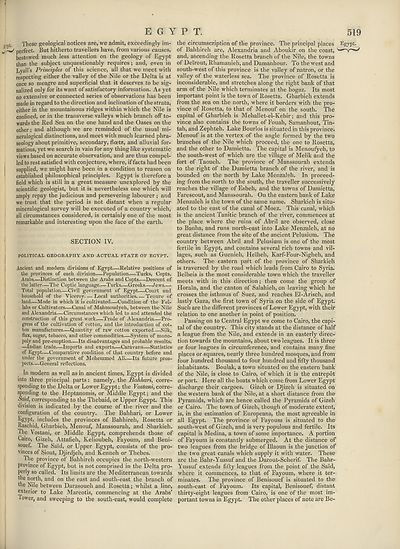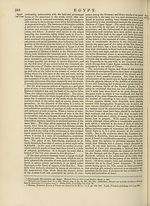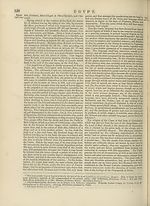Encyclopaedia Britannica > Volume 8, DIA-England
(529) Page 519
Download files
Complete book:
Individual page:
Thumbnail gallery: Grid view | List view

EGYPT.
519
t These geological notices are, we admit, exceedingly im-
perfect. But hitherto travellers have, from various causes,
bestowed much less attention on the geology of Egypt
than the subject unquestionably requires; and, even in
Lyall’s Principles of this science, all that we meet with
respecting either the valley of the Nile or the Delta is at
once so meagre and superficial that it deserves to be sig¬
nalized only for its want of satisfactory information. As yet
no extensive or connected series of observations has been
made in regard to the direction and inclination of the strata,
either in the mountainous ridges within which the Nile is
confined, or in the transverse valleys which branch off to¬
wards the Red Sea on the one hand and the Oases on the
other; and although we are reminded of the usual mi-
neralogical distinctions, and meet with much learned phra¬
seology about primitive, secondary, fleet?:, and alluvial for¬
mations, yet we search in vain for any thing like systematic
views based on accurate observation, and are thus compel¬
led to rest satisfied with conjecture, where, if facts had been
supplied, we might have been in a condition to reason on
established philosophical principles. Egypt is therefore a
field which is still in a great measure unexplored by the
scientific geologist, but it is nevertheless one which will
amply repay the judicious and persevering labourer ; and
we trust that the period is not distant when a regular
mineralogical survey will be executed of a country which,
all circumstances considered, is certainly one of the most
remarkable and interesting upon the face of the earth.
SECTION IV.
POLITICAL GEOGRAPHY AND ACTUAL STATE OF EGYPT.
Ancient and modern divisions of Egypt—Relative positions of
the provinces of each division.—Population—Turks, Copts,
Arabs—Distinction between the Arabs and Copts Descent of
the latter—The Coptic language.,—Turks—Greeks—Jews
Total population—Civil government of Egypt Court and
household of the Viceroy Local authorities Tenure of
land—Mode in which it is cultivated—Condition of the Fel¬
lahs or Cultivators.—Canal of Mahmoudyeh, between the Nile
and Alexandria—Circumstances which led to and attended the
construction of this great work.—Trade of Alexandria Pro¬
gress of the cultivation of cotton, and the introduction of cot¬
ton manufactures—Quantity of raw cotton exported Silk,
flax, sugar, tobacco, and other commodities.—System of mono¬
poly and pre-emption—Its disadvantages and probable results.
—Indian trade—Imports and exports.—Caravans—Statistics
of Egypt.—Comparative condition of that country before and
under the government of Mehemmed Ali.—Its future pros¬
pects.—General reflections.
In modern as well as in ancient times, Egypt is divided
into three principal parts: namely, the Bahhari, corre¬
sponding to the Delta or Lower Egypt; the Vostani, corre¬
sponding to the Heptanomis, or Middle Egypt; and the
Said, corresponding to the Thebaid, or Upper Egypt. This
division is indicated by the course of the river and the
configuration of the country. The Bahhari, or Lower
Egypt, includes the provinces of Bahhireh, Rosetta or
Raschid, Gharbieh, Menouf, Manssourah, and Sharkieh.
The Vostani, or Middle Egypt, comprehends those of
Cairo, Gizeh, Attafieh, Kelioubeh, Fayoum, and Beni-
souef. The Said, or Upper Egypt, consists of the pro¬
vinces of Siout, Djirdjeh, and Kenneh or Thebes.
The province of Bahhireh occupies the north-western
province of Egypt, but is not comprised in the Delta pro¬
perly so called. Its limits are the Mediterranean towards
the north, and on the east and south-east the branch of
the Nile between Darasoueh and Rosetta; whilst a line,
exterior to Lake Mareotis, commencing at the Arabs’
tower, and sweeping to the south-east, would complete
the circumscription of the province. The principal places
of Bahhireh are, Alexandria and Aboukir on the coast,
and, ascending the Rosetta branch of the Nile, the towns
of Dei'rout, Rhamanieh, and Damanhour. To the west and
south-west of this province is the valley of natron, or the
valley of the waterless sea. The province of Rosetta is
inconsiderable, and stretches along the right bank of that
arm of the Nile which terminates at the bogaz. Its most
important point is the town of Rosetta. Gharbieh extends
from the sea on the north, where it borders with the pro¬
vince of Rosetta, to that of Menouf on the south. The
capital of Gharbieh is Mehallet-el-Kebir; and this pro¬
vince also contains the towns of Fouah, Samanhout, Tin-
tah, and Zephteh. Lake Bourlos is situated in this province.
Menouf is at the vertex of the angle formed by the two
branches of the Nile which proceed, the one to Rosetta,
and the other to Damietta. The capital is Menoufyeh, to
the south-west of which are the village of Melik and the
fort of Taoueh. The province of Manssourah extends
to the right of the Damietta branch of the river, and is
bounded on the north by Lake Menzaleh. In proceed¬
ing from the north to the south, the traveller successively
reaches the village of Esbeh, and the towns of Damietta,
Farescout, and Manssourah. On the eastern bank of Lake
Menzaleh is the town of the same name. Sharkieh is situ¬
ated to the east of the canal of Moez. This canal, which
is the ancient Tanitic branch of the river, commences at
the place where the ruins of Abril are observed, close
to Banha, and runs north-east into Lake Menzaleh, at no
great distance from the site of the ancient Pelusium. The
country between Abril and Pelusium is one of the most
fertile in Egypt, and contains several rich towns and vil¬
lages, such as Guenieh, Heiheh, Karf-Four-Nigheh, and
others. The eastern part of the province of Sharkieh
is traversed by the road which leads from Cairo to Syria.
Belbeis is the most considerable town which the traveller
meets with in this direction; then come the group of
Hora'in, and the canton of Salahieh, on leaving which he
crosses the isthmus of Suez, and reaches El-Arisch, and
lastly Gaza, the first town of Syria on the side of Egypt.
Such are the different provinces of Lower Egypt, with their
relation to one another in point of position.
Passing on to Central Egypt we come to Cairo, the capi¬
tal of the country. This city stands at the distance of half
a league from the Nile, and extends in an easterly direc¬
tion towards the mountains, about two leagues. It is three
or four leagues in circumference, and contains many fine
places or squares, nearly three hundred mosques, and from
four hundred thousand to four hundred and fifty thousand
inhabitants. Boulak, a town situated on the eastern bank
of the Nile, is close to Cairo, of which it is the entrepot
or port. Here all the boats which come from Lower Egypt
discharge their cargoes. Gizeh or Djizeh is situated on
the western bank of the Nile, at a short distance from the
Pyramids, which are hence called the Pyramids of Gizeh
or Cairo. The town of Gizeh, though of moderate extent,
is, in the estimation of Europeans, the most agreeable in
all Egypt. The province of Fayoum is situated to the
south-west of Gizeh, and is very populous and fertile. Its
capital is Medina, a town of some importance. A portion
of Fayoum is constantly submerged. At the distance of
two leagues from the bridge of Illaoun is the junction of
the two great canals which supply it with water. These
are the Bahr-Yussuf and the Darout-Scherif. The Bahr-
Yussuf extends fifty leagues from the point of the Said,
where it commences, to that of Fayoum, where it ter¬
minates. The province of Benisouef is situated to the
south-east of Fayoum. Its capital, Benisouef, distant
thirty-eight leagues from Cairo, is one of the most im¬
portant towns in Egypt. The other places of note are Be-
Egypt.
519
t These geological notices are, we admit, exceedingly im-
perfect. But hitherto travellers have, from various causes,
bestowed much less attention on the geology of Egypt
than the subject unquestionably requires; and, even in
Lyall’s Principles of this science, all that we meet with
respecting either the valley of the Nile or the Delta is at
once so meagre and superficial that it deserves to be sig¬
nalized only for its want of satisfactory information. As yet
no extensive or connected series of observations has been
made in regard to the direction and inclination of the strata,
either in the mountainous ridges within which the Nile is
confined, or in the transverse valleys which branch off to¬
wards the Red Sea on the one hand and the Oases on the
other; and although we are reminded of the usual mi-
neralogical distinctions, and meet with much learned phra¬
seology about primitive, secondary, fleet?:, and alluvial for¬
mations, yet we search in vain for any thing like systematic
views based on accurate observation, and are thus compel¬
led to rest satisfied with conjecture, where, if facts had been
supplied, we might have been in a condition to reason on
established philosophical principles. Egypt is therefore a
field which is still in a great measure unexplored by the
scientific geologist, but it is nevertheless one which will
amply repay the judicious and persevering labourer ; and
we trust that the period is not distant when a regular
mineralogical survey will be executed of a country which,
all circumstances considered, is certainly one of the most
remarkable and interesting upon the face of the earth.
SECTION IV.
POLITICAL GEOGRAPHY AND ACTUAL STATE OF EGYPT.
Ancient and modern divisions of Egypt—Relative positions of
the provinces of each division.—Population—Turks, Copts,
Arabs—Distinction between the Arabs and Copts Descent of
the latter—The Coptic language.,—Turks—Greeks—Jews
Total population—Civil government of Egypt Court and
household of the Viceroy Local authorities Tenure of
land—Mode in which it is cultivated—Condition of the Fel¬
lahs or Cultivators.—Canal of Mahmoudyeh, between the Nile
and Alexandria—Circumstances which led to and attended the
construction of this great work.—Trade of Alexandria Pro¬
gress of the cultivation of cotton, and the introduction of cot¬
ton manufactures—Quantity of raw cotton exported Silk,
flax, sugar, tobacco, and other commodities.—System of mono¬
poly and pre-emption—Its disadvantages and probable results.
—Indian trade—Imports and exports.—Caravans—Statistics
of Egypt.—Comparative condition of that country before and
under the government of Mehemmed Ali.—Its future pros¬
pects.—General reflections.
In modern as well as in ancient times, Egypt is divided
into three principal parts: namely, the Bahhari, corre¬
sponding to the Delta or Lower Egypt; the Vostani, corre¬
sponding to the Heptanomis, or Middle Egypt; and the
Said, corresponding to the Thebaid, or Upper Egypt. This
division is indicated by the course of the river and the
configuration of the country. The Bahhari, or Lower
Egypt, includes the provinces of Bahhireh, Rosetta or
Raschid, Gharbieh, Menouf, Manssourah, and Sharkieh.
The Vostani, or Middle Egypt, comprehends those of
Cairo, Gizeh, Attafieh, Kelioubeh, Fayoum, and Beni-
souef. The Said, or Upper Egypt, consists of the pro¬
vinces of Siout, Djirdjeh, and Kenneh or Thebes.
The province of Bahhireh occupies the north-western
province of Egypt, but is not comprised in the Delta pro¬
perly so called. Its limits are the Mediterranean towards
the north, and on the east and south-east the branch of
the Nile between Darasoueh and Rosetta; whilst a line,
exterior to Lake Mareotis, commencing at the Arabs’
tower, and sweeping to the south-east, would complete
the circumscription of the province. The principal places
of Bahhireh are, Alexandria and Aboukir on the coast,
and, ascending the Rosetta branch of the Nile, the towns
of Dei'rout, Rhamanieh, and Damanhour. To the west and
south-west of this province is the valley of natron, or the
valley of the waterless sea. The province of Rosetta is
inconsiderable, and stretches along the right bank of that
arm of the Nile which terminates at the bogaz. Its most
important point is the town of Rosetta. Gharbieh extends
from the sea on the north, where it borders with the pro¬
vince of Rosetta, to that of Menouf on the south. The
capital of Gharbieh is Mehallet-el-Kebir; and this pro¬
vince also contains the towns of Fouah, Samanhout, Tin-
tah, and Zephteh. Lake Bourlos is situated in this province.
Menouf is at the vertex of the angle formed by the two
branches of the Nile which proceed, the one to Rosetta,
and the other to Damietta. The capital is Menoufyeh, to
the south-west of which are the village of Melik and the
fort of Taoueh. The province of Manssourah extends
to the right of the Damietta branch of the river, and is
bounded on the north by Lake Menzaleh. In proceed¬
ing from the north to the south, the traveller successively
reaches the village of Esbeh, and the towns of Damietta,
Farescout, and Manssourah. On the eastern bank of Lake
Menzaleh is the town of the same name. Sharkieh is situ¬
ated to the east of the canal of Moez. This canal, which
is the ancient Tanitic branch of the river, commences at
the place where the ruins of Abril are observed, close
to Banha, and runs north-east into Lake Menzaleh, at no
great distance from the site of the ancient Pelusium. The
country between Abril and Pelusium is one of the most
fertile in Egypt, and contains several rich towns and vil¬
lages, such as Guenieh, Heiheh, Karf-Four-Nigheh, and
others. The eastern part of the province of Sharkieh
is traversed by the road which leads from Cairo to Syria.
Belbeis is the most considerable town which the traveller
meets with in this direction; then come the group of
Hora'in, and the canton of Salahieh, on leaving which he
crosses the isthmus of Suez, and reaches El-Arisch, and
lastly Gaza, the first town of Syria on the side of Egypt.
Such are the different provinces of Lower Egypt, with their
relation to one another in point of position.
Passing on to Central Egypt we come to Cairo, the capi¬
tal of the country. This city stands at the distance of half
a league from the Nile, and extends in an easterly direc¬
tion towards the mountains, about two leagues. It is three
or four leagues in circumference, and contains many fine
places or squares, nearly three hundred mosques, and from
four hundred thousand to four hundred and fifty thousand
inhabitants. Boulak, a town situated on the eastern bank
of the Nile, is close to Cairo, of which it is the entrepot
or port. Here all the boats which come from Lower Egypt
discharge their cargoes. Gizeh or Djizeh is situated on
the western bank of the Nile, at a short distance from the
Pyramids, which are hence called the Pyramids of Gizeh
or Cairo. The town of Gizeh, though of moderate extent,
is, in the estimation of Europeans, the most agreeable in
all Egypt. The province of Fayoum is situated to the
south-west of Gizeh, and is very populous and fertile. Its
capital is Medina, a town of some importance. A portion
of Fayoum is constantly submerged. At the distance of
two leagues from the bridge of Illaoun is the junction of
the two great canals which supply it with water. These
are the Bahr-Yussuf and the Darout-Scherif. The Bahr-
Yussuf extends fifty leagues from the point of the Said,
where it commences, to that of Fayoum, where it ter¬
minates. The province of Benisouef is situated to the
south-east of Fayoum. Its capital, Benisouef, distant
thirty-eight leagues from Cairo, is one of the most im¬
portant towns in Egypt. The other places of note are Be-
Egypt.
Set display mode to:
![]() Universal Viewer |
Universal Viewer | ![]() Mirador |
Large image | Transcription
Mirador |
Large image | Transcription
Images and transcriptions on this page, including medium image downloads, may be used under the Creative Commons Attribution 4.0 International Licence unless otherwise stated. ![]()
| Encyclopaedia Britannica > Encyclopaedia Britannica > Volume 8, DIA-England > (529) Page 519 |
|---|
| Permanent URL | https://digital.nls.uk/193329882 |
|---|
| Attribution and copyright: |
|
|---|
| Description | Ten editions of 'Encyclopaedia Britannica', issued from 1768-1903, in 231 volumes. Originally issued in 100 weekly parts (3 volumes) between 1768 and 1771 by publishers: Colin Macfarquhar and Andrew Bell (Edinburgh); editor: William Smellie: engraver: Andrew Bell. Expanded editions in the 19th century featured more volumes and contributions from leading experts in their fields. Managed and published in Edinburgh up to the 9th edition (25 volumes, from 1875-1889); the 10th edition (1902-1903) re-issued the 9th edition, with 11 supplementary volumes. |
|---|---|
| Additional NLS resources: |
|

